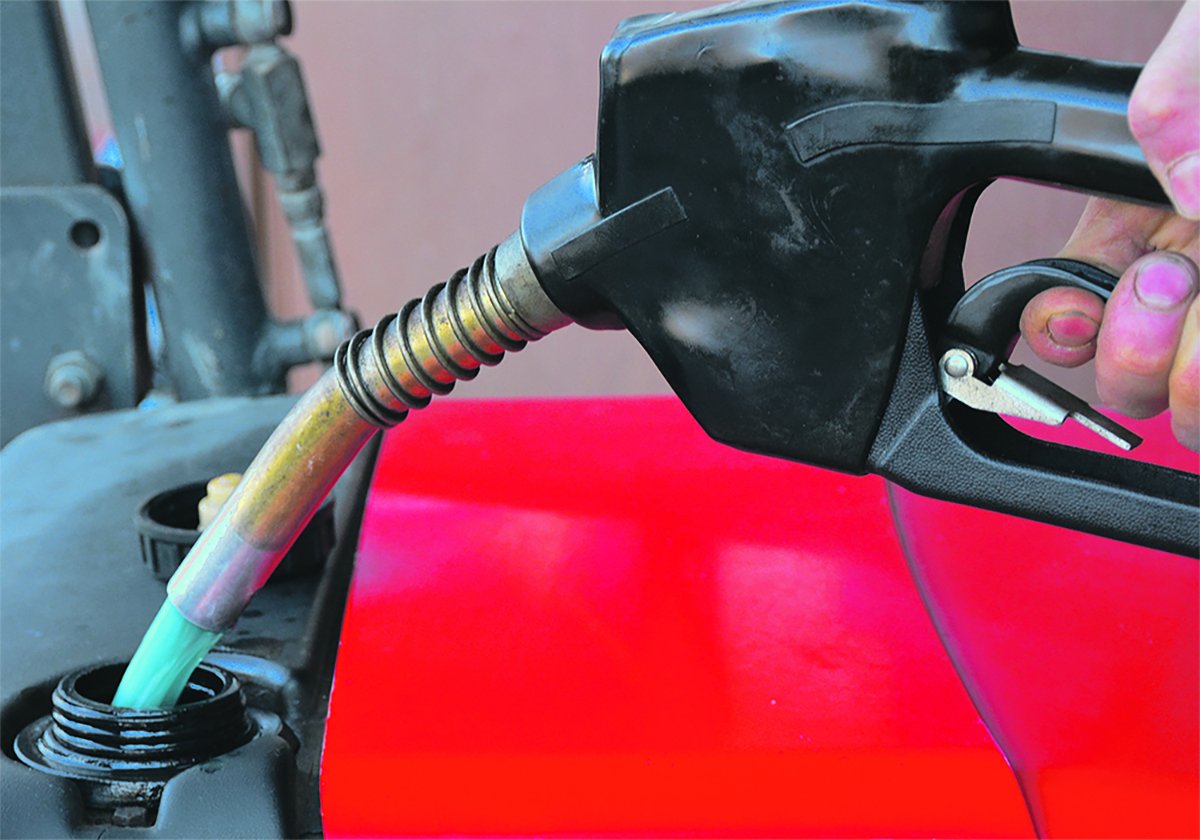As sure as death and taxes, the cost of farming only moves in one direction: higher.
The new custom rate guides for the three prairie provinces show that trend in spades. Driven by higher fuel prices, scarce labour and strong demand for new equipment, the cost of getting a crop in and off has risen straight across the board, with few exceptions.
Dale Robinson, a business management specialist with Alberta Agriculture, said costs typically move up about five percent a year because custom operators are looking to cover not only their variable costs and time – which have also climbed this year – but also their depreciation and ownership costs.
Read Also

Alberta may eliminate marked fuel
Alberta may soon stop selling dyed gasoline and diesel.
“The cost of replacing the equipment is going up so much that guys don’t want to do it for the lower price as a favour, because if they do that long enough, they can’t afford to replace the machine,” he said.
The new custom rate calculations available from provincial government websites base machinery costs on the estimated replacement value of new equipment.
“In a lot of cases, we’re not looking at using the $50,000 second-hand tractor,” Robinson said.
“We’re using the $130,000 replacement price in calculating those costs before setting the rates.”
He said the higher cost of fuel, which has jumped to $1.05 per litre for coloured diesel this spring from 40 cents in recent years, has led to confusion about appropriate pricing for custom work.
For example, with fuel up 20 cents a litre over last year, a custom baler using 40 litres of fuel per hour would face an added cost of slightly more than $8 per hour.
“That might only be 40 cents a bale. But all of sudden you’ll see them say, ‘it was $8 to $9 last year, I think we need $10 this year,’ ” he said.
“They’re rounding it up in even dollars. The increases in the custom rates aren’t necessarily just the fuel costs.”
Ralph Howes, an agriculture management specialist with Saskatchewan Agriculture, said higher diesel prices and replacement costs have led to a 17 percent increase over last year in the hourly rates for tractors in the 400 to 425 horsepower range. Rates were $120 per hour in 2006.
Some farmers have had trouble getting their hands on new tractors, combines and other large equipment because a decade of low grain prices left many with no choice but to make do with what they had.
Now, amid a stampede for new equipment, supplies are tight. Peter Blawat, a Manitoba Agriculture policy economist who helped write the province’s custom rates guide for 2008, said a farmer he knows had to drive to St. Louis, Missouri, to pick up a combine.
He said this year’s guide shows rising fertilizer, seed, fuel, repair and labour costs have influenced custom rates. Pesticide prices and crop insurance rates may also go up, he added.
However, he said farmers will still make money this year because higher commodity prices will more than cover the cost of farming.
“In the past, a reasonable margin meant that if you take the income minus operating expenses, there was about $50 per acre left to pay debts. Right now, they’ve got a $120 to $130 margin,” Blawat said.
“There’s still a bit of room for costs to creep up, and they will creep up.”
Howes said three-ton truck prices are up six percent, while tandems are up eight percent. Air drills are nine percent more expensive than last year.
“These are items that are really in strong demand: air drills, three-ton trucks, high clearance sprayers and large tractors.”
Not everything is going up. Howes said the price for conventional, Class 7 combines is down 10 percent, while prices for rotary models in that class are unchanged.
Large round balers are down four percent, but bale processors are up 10 percent.
Robinson said more farmers are hiring custom operators because of the labor shortage, a trend that puts more negotiating power in the hands of operators with reliable workers.
“What we’re seeing is that the rates in a lot of cases stayed pretty flat for a long time and the cost of machinery didn’t,” he said.
“So now we’re finding that the rates are moving a little more often.”
Labour continues to be scarce because of the shrinking pool of experienced farm kids and retired farmers willing to help out during busy times. On the other hand, many young farmers with big investments in equipment actively seek out customers after their own fieldwork is finished early in the season.
Neighbours who help out are paid around $15 an hour as a “token” wage, while unskilled workers driving a grain truck are paid $18 to $20 per hour. Skilled combine and GPS-savvy air seeder drivers earn up to $25 per hour, Robinson said.
“Finding a person is the first thing. It has to be someone who can adjust the settings and keep it out of the trees, and so forth.”
Howes said Saskatchewan farmers pay up to $20 per hour for good combine operators and more than $13 per hour for semi-skilled workers.
Larger operations have discovered that it pays to find ways to keep hired hands on the payroll year round.
“It’s too risky to have to just go find new help every year.”
Blawat said skilled workers should receive at least $20 per hour.
In Alberta, Robinson said custom operators have captured much of the summer silage work because of the labour shortage.
“I’ve talked to producers who have the pull-type chopper, the dump wagon and the trucks sitting in their yard, but they can’t find enough bodies to put in the seats,” he said.
Robinson said the cost of custom work varies widely. In seeding, for example, the rate depends on how much the customer is willing to help.
Hiring a no-till air seeder, which used to cost $12 to $13 per acre, now costs as much as $25 an acre for a full service package.
“We’re starting to see a dual-range,” Robinson said.
“For $14 to $16, your neighbour comes over with their tractor and seeder and you get out there with your grain truck and drill fill and make sure he’s filled up and busy.”
For $20 to $25, the custom operator has his own truck with a helper and makes extra runs for seed and fertilizer.
With Roundup Ready varieties needing multiple spray treatments per season, demand for high-clearance sprayers is up across the Prairies.
Robinson said larger operations that also do custom work are finding that buying a new unit is worth the investment, especially now that rates have risen to $7 per acre, up from $5 two years ago.
Smaller farms are buying used sprayers and importing them from the United States, he added. However, many farmers are willing to pay more for the speed and mobility that a high clearance sprayer offers.
“With the clubroot issue in canola and the need to clean machines between fields, there has been a decrease in the availability of custom operators,” he said.
“The demand is incredible. Trail-type sprayers are the thing that doesn’t sell at the auction sale.”














